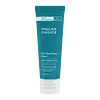What's inside
What's inside
 Key Ingredients
Key Ingredients

 Benefits
Benefits

 Concerns
Concerns

 Ingredients Side-by-side
Ingredients Side-by-side

Water
Skin ConditioningKaolin
AbrasiveBentonite
AbsorbentGlycerin
HumectantSalix Alba Extract
Skin ConditioningStearic Acid
CleansingSteareth-2
EmulsifyingAloe Barbadensis Leaf Juice Powder
Skin ConditioningSea Whip Extract
Skin ConditioningColloidal Oatmeal
AbsorbentBisabolol
MaskingAscorbyl Palmitate
AntioxidantTocopheryl Acetate
AntioxidantPhospholipids
Skin ConditioningPanthenol
Skin ConditioningRetinyl Palmitate
Skin ConditioningCaprylyl Glycol
EmollientButylene Glycol
HumectantEthylhexylglycerin
Skin ConditioningHexylene Glycol
EmulsifyingDisodium EDTA
Phenoxyethanol
PreservativeWater, Kaolin, Bentonite, Glycerin, Salix Alba Extract, Stearic Acid, Steareth-2, Aloe Barbadensis Leaf Juice Powder, Sea Whip Extract, Colloidal Oatmeal, Bisabolol, Ascorbyl Palmitate, Tocopheryl Acetate, Phospholipids, Panthenol, Retinyl Palmitate, Caprylyl Glycol, Butylene Glycol, Ethylhexylglycerin, Hexylene Glycol, Disodium EDTA, Phenoxyethanol
Water
Skin ConditioningGlycerin
HumectantSodium Acrylates Crosspolymer-2
AbsorbentKaolin
AbrasiveCharcoal Powder
AbrasiveBetaine
HumectantPeat
Skin ConditioningPhenoxyethanol
PreservativePolyglyceryl-4 Laurate/Sebacate
SolventPolyglyceryl-6 Caprylate/Caprate
StabilisingBetula Alba Juice
AstringentLactic Acid
BufferingChlorphenesin
AntimicrobialSalix Nigra Bark Extract
Skin ProtectingDisodium EDTA
Polyquaternium-39
Parfum
MaskingPropylene Glycol
HumectantSilica
AbrasiveSalix Daphnoides Bud/Leaf/Stem Extract
Skin ConditioningSalix Alba Bark Extract
AstringentXanthan Gum
EmulsifyingSodium Benzoate
MaskingHydrolyzed Yeast Protein
Skin ConditioningMelilotus Officinalis Extract
AstringentCitric Acid
BufferingCitrus Aurantium Amara Leaf/Twig Oil
MaskingPotassium Sorbate
PreservativeAnthemis Nobilis Flower Oil
MaskingCistus Ladaniferus Oil
EmollientHelichrysum Angustifolium Flower Extract
MaskingWater, Glycerin, Sodium Acrylates Crosspolymer-2, Kaolin, Charcoal Powder, Betaine, Peat, Phenoxyethanol, Polyglyceryl-4 Laurate/Sebacate, Polyglyceryl-6 Caprylate/Caprate, Betula Alba Juice, Lactic Acid, Chlorphenesin, Salix Nigra Bark Extract, Disodium EDTA, Polyquaternium-39, Parfum, Propylene Glycol, Silica, Salix Daphnoides Bud/Leaf/Stem Extract, Salix Alba Bark Extract, Xanthan Gum, Sodium Benzoate, Hydrolyzed Yeast Protein, Melilotus Officinalis Extract, Citric Acid, Citrus Aurantium Amara Leaf/Twig Oil, Potassium Sorbate, Anthemis Nobilis Flower Oil, Cistus Ladaniferus Oil, Helichrysum Angustifolium Flower Extract
 Reviews
Reviews

Ingredients Explained
These ingredients are found in both products.
Ingredients higher up in an ingredient list are typically present in a larger amount.
Disodium EDTA plays a role in making products more stable by aiding other preservatives.
It is a chelating agent, meaning it neutralizes metal ions that may be found in a product.
Disodium EDTA is a salt of edetic acid and is found to be safe in cosmetic ingredients.
Learn more about Disodium EDTAGlycerin is already naturally found in your skin. It helps moisturize and protect your skin.
A study from 2016 found glycerin to be more effective as a humectant than AHAs and hyaluronic acid.
As a humectant, it helps the skin stay hydrated by pulling moisture to your skin. The low molecular weight of glycerin allows it to pull moisture into the deeper layers of your skin.
Hydrated skin improves your skin barrier; Your skin barrier helps protect against irritants and bacteria.
Glycerin has also been found to have antimicrobial and antiviral properties. Due to these properties, glycerin is often used in wound and burn treatments.
In cosmetics, glycerin is usually derived from plants such as soybean or palm. However, it can also be sourced from animals, such as tallow or animal fat.
This ingredient is organic, colorless, odorless, and non-toxic.
Glycerin is the name for this ingredient in American English. British English uses Glycerol/Glycerine.
Learn more about GlycerinKaolin is a clay. It is used for oil control and to help minimize pores. Like other clays, kaolin has the ability to absorb excess sebum or oil. This can help clean out pores and mattify the skin.
Some types of kaolin may have exfoliating properties. When water is added to kaolin, it becomes a paste with small abrasive particles.
Most kaolin is a white color, but may be pink/orange/red depending on where it comes from.
The name 'kaolin' comes from a Chinese village named 'Gaoling'. Kaolin clay comes from rocks rich in kaolinite. Kaolinite, the mineral, has a silicate layered structure. Kaolinite is formed from chemical weathering of aluminum siilicate minerals.
Besides skincare, kaolin is commonly used to make glossy paper, in ceramics, toothpaste, and as medicine to soothe stomach issues.
Learn more about KaolinPhenoxyethanol is a preservative that has germicide, antimicrobial, and aromatic properties. Studies show that phenoxyethanol can prevent microbial growth. By itself, it has a scent that is similar to that of a rose.
It's often used in formulations along with Caprylyl Glycol to preserve the shelf life of products.
Water. It's the most common cosmetic ingredient of all. You'll usually see it at the top of ingredient lists, meaning that it makes up the largest part of the product.
So why is it so popular? Water most often acts as a solvent - this means that it helps dissolve other ingredients into the formulation.
You'll also recognize water as that liquid we all need to stay alive. If you see this, drink a glass of water. Stay hydrated!
Learn more about Water